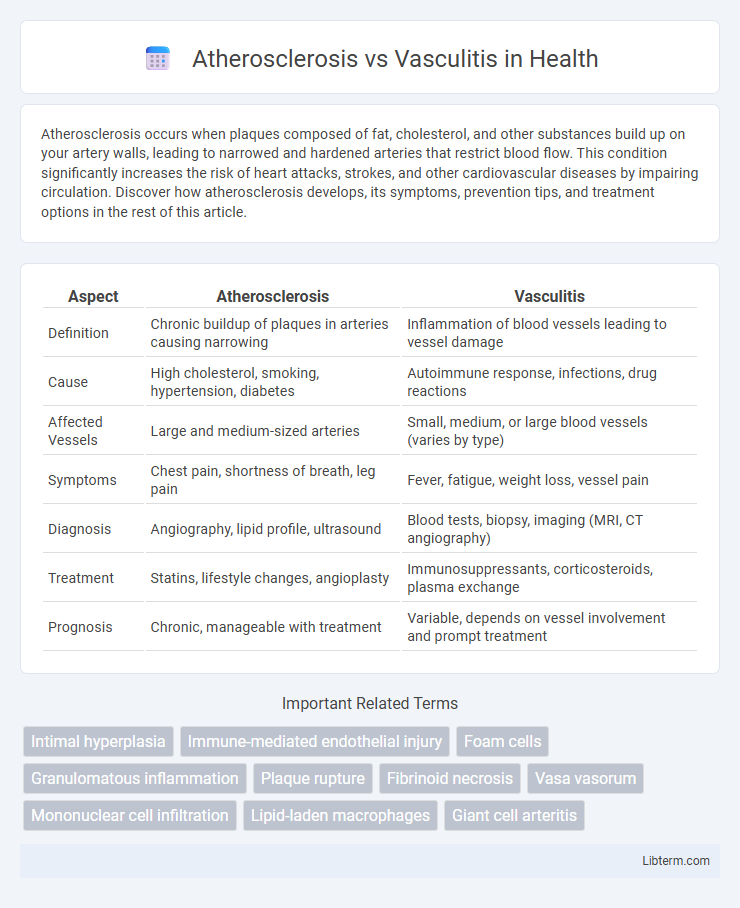Atherosclerosis occurs when plaques composed of fat, cholesterol, and other substances build up on your artery walls, leading to narrowed and hardened arteries that restrict blood flow. This condition significantly increases the risk of heart attacks, strokes, and other cardiovascular diseases by impairing circulation. Discover how atherosclerosis develops, its symptoms, prevention tips, and treatment options in the rest of this article.
Table of Comparison
| Aspect | Atherosclerosis | Vasculitis |
|---|---|---|
| Definition | Chronic buildup of plaques in arteries causing narrowing | Inflammation of blood vessels leading to vessel damage |
| Cause | High cholesterol, smoking, hypertension, diabetes | Autoimmune response, infections, drug reactions |
| Affected Vessels | Large and medium-sized arteries | Small, medium, or large blood vessels (varies by type) |
| Symptoms | Chest pain, shortness of breath, leg pain | Fever, fatigue, weight loss, vessel pain |
| Diagnosis | Angiography, lipid profile, ultrasound | Blood tests, biopsy, imaging (MRI, CT angiography) |
| Treatment | Statins, lifestyle changes, angioplasty | Immunosuppressants, corticosteroids, plasma exchange |
| Prognosis | Chronic, manageable with treatment | Variable, depends on vessel involvement and prompt treatment |
Introduction to Atherosclerosis and Vasculitis
Atherosclerosis is a chronic condition characterized by the buildup of plaques composed of lipids, cholesterol, and cellular debris within arterial walls, leading to narrowed and hardened arteries. Vasculitis involves inflammation of blood vessels, causing vessel wall damage and impaired blood flow, and can affect arteries, veins, or capillaries in various organ systems. Both conditions disrupt normal vascular function but differ fundamentally in their underlying pathology--atherosclerosis as a degenerative process and vasculitis as an inflammatory disorder.
Defining Atherosclerosis: Causes and Risk Factors
Atherosclerosis is a chronic condition characterized by the buildup of plaque composed of fat, cholesterol, and calcium within arterial walls, leading to narrowed and hardened arteries. Key causes include high LDL cholesterol, hypertension, smoking, diabetes, and a sedentary lifestyle, all of which contribute to endothelial damage and inflammation. Risk factors such as age, family history, obesity, and poor diet exacerbate plaque formation and arterial stiffness, increasing the likelihood of cardiovascular events.
Understanding Vasculitis: Types and Triggers
Vasculitis is an inflammatory condition affecting blood vessels and is classified into various types such as giant cell arteritis, Takayasu arteritis, and polyarteritis nodosa, each targeting different vessel sizes and regions. Triggers for vasculitis include autoimmune disorders, infections, and genetic predispositions, leading to vessel wall inflammation, damage, and impaired blood flow. Differentiating vasculitis from atherosclerosis is crucial as vasculitis involves immune-mediated inflammation, while atherosclerosis results from plaque buildup due to lipid accumulation and endothelial injury.
Pathophysiology: How Do Atherosclerosis and Vasculitis Differ?
Atherosclerosis is characterized by the buildup of lipid-laden plaques within arterial walls, leading to chronic inflammation and arterial narrowing primarily due to endothelial injury and lipid oxidation. Vasculitis involves immune-mediated inflammation targeting the blood vessel wall, causing leukocyte infiltration, vessel wall destruction, and potential aneurysm or occlusion. The pathophysiological distinction lies in atherosclerosis being a degenerative process driven by lipid accumulation and macrophage activity, whereas vasculitis is an autoimmune-driven inflammatory condition affecting vessel integrity.
Clinical Manifestations: Signs and Symptoms Compared
Atherosclerosis primarily presents with symptoms related to organ ischemia, such as angina pectoris, claudication, and transient ischemic attacks, caused by arterial plaque buildup and blood flow obstruction. Vasculitis manifests with systemic signs including fever, weight loss, and fatigue, accompanied by localized symptoms like palpable purpura, muscle weakness, and neuropathy due to vessel inflammation and tissue ischemia. Both conditions cause vascular compromise, but atherosclerosis is typically chronic with progressive arterial narrowing, while vasculitis often presents acutely with inflammation-induced vessel damage.
Diagnostic Approaches for Atherosclerosis vs Vasculitis
Diagnostic approaches for atherosclerosis primarily involve imaging techniques such as ultrasound, CT angiography, and MRI to detect arterial plaque buildup and vessel narrowing. In contrast, vasculitis diagnosis relies on a combination of blood tests for inflammatory markers, biopsy of affected tissues, and angiography to identify blood vessel inflammation and damage. Both conditions require tailored diagnostic methods to distinguish between plaque-induced arterial obstruction in atherosclerosis and immune-mediated vessel inflammation in vasculitis.
Key Differences in Treatment Strategies
Atherosclerosis treatment primarily involves lipid-lowering agents such as statins, antiplatelet therapy, and lifestyle modifications including diet and exercise to prevent plaque buildup and cardiovascular events. Vasculitis management requires immunosuppressive medications like corticosteroids and cytotoxic drugs to control inflammation and prevent vessel damage. While atherosclerosis targets cholesterol reduction and thrombosis prevention, vasculitis focuses on dampening the immune response and inflammation control.
Long-Term Prognosis and Complications
Atherosclerosis, characterized by plaque buildup in arterial walls, often leads to chronic complications such as coronary artery disease, stroke, and peripheral artery disease, significantly impacting long-term prognosis with increased risk of cardiovascular events and mortality. Vasculitis involves inflammation of blood vessels, which can cause tissue ischemia and organ damage, with long-term outcomes varying based on the type and severity of vasculitis, often necessitating immunosuppressive treatment to prevent relapse and organ failure. Both conditions require ongoing management to mitigate risks of complications like aneurysms, thrombosis, and irreversible organ impairment, highlighting the importance of early diagnosis and tailored therapeutic strategies.
Prevention and Lifestyle Modifications
Preventing atherosclerosis primarily involves maintaining healthy cholesterol levels, controlling blood pressure, avoiding smoking, and adopting a diet rich in fruits, vegetables, whole grains, and healthy fats to reduce plaque buildup in arteries. Lifestyle modifications for vasculitis focus on managing inflammation through stress reduction, adequate rest, and avoiding triggers such as infections and smoking that may exacerbate vascular inflammation. Regular physical activity and routine medical monitoring play crucial roles in reducing the risk and progression of both atherosclerosis and vasculitis by promoting cardiovascular health and early detection of disease flares.
Conclusion: Choosing the Right Approach for Each Condition
Atherosclerosis requires a treatment strategy centered on lipid management, lifestyle modification, and antiplatelet therapy to reduce plaque buildup and prevent cardiovascular events. Vasculitis demands immunosuppressive therapy targeting inflammation and immune response to control vessel damage and reduce systemic symptoms. Accurate diagnosis with imaging and biomarkers is essential to tailor effective interventions specific to the underlying pathology.
Atherosclerosis Infographic

 libterm.com
libterm.com